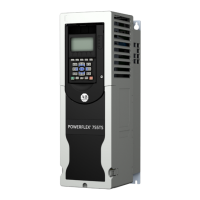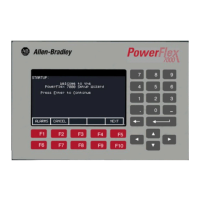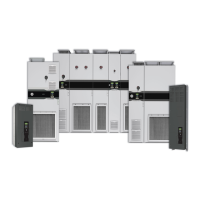112 Rockwell Automation Publication 20A-UM001N-EN-P - July 2013
Appendix C Application Notes
Ramp
This method uses drive output reduction to stop the load. Ramp is selected by setting [Stop Mode A/B]
to a value of “1”. The drive ramps the frequency to zero based on the deceleration time programmed
into [Decel Time 1/2]. The “normal” mode of machine operation can utilize [Decel Time 1]. If the
machine “stop” requires a faster deceleration than desired for normal deceleration, [Decel Time 2] can
be activated with a faster rate selected. When in Ramp mode, the drive acknowledges the stop
command by decreasing or “ramping” the output voltage and frequency to zero in a programmed
period (Decel Time), maintaining control of the motor until the drive output reaches zero. The drive
output is then shut off. The load and motor follow the decel ramp. Other factors such as bus regulation
and current limit can alter the actual decal rate.
Ramp mode can also include a “timed” hold brake. Once the drive has reached zero output hertz on a
Ramp-to-Stop and both parameters [DC Brake Time] and [DC Brake Level] are not zero, the drive
applies DC to the motor producing current at the DC Brake Level for the DC Brake Time.
1. On Stop, drive output decreases according to the programmed pattern from its present value to
zero. The pattern can be linear or squared. The output decreases to zero at the rate determined by
the programmed [Maximum Freq] and the programmed active [Decel Time x].
2. The reduction in output can be limited by other drive factors such as bus or current regulation.
3. When the output reaches zero the output is shut off.
4. The motor, if rotating, coasts from its present speed for a time that is dependent on the mechanics
of the system (inertia, friction, and so on).
Ramp to Hold
This method combines two of the methods above. It uses drive output reduction to stop the load and
DC injection to hold the load at zero speed once it has stopped.
1. On Stop, drive output decreases according to the programmed pattern from its present value to
zero. The pattern can be linear or squared. The output decreases to zero at the rate determined by
the programmed [Maximum Freq] and the programmed active [Decel Time x].
2. The reduction in output can be limited by other drive factors such as bus or current regulation.
3. When the output reaches zero, 3 phase drive output goes to zero (off) and the drive outputs DC
voltage on the last used phase at the level programmed in [DC Brake Level], parameter 158. This
voltage causes a “holding” brake torque.
4. DC voltage to the motor continues until a Start command is reissued or the drive is disabled.
5. If a Start command is reissued, DC Braking ceases and the drive returns to normal AC operation. If an
Enable command is removed, the drive enters a “not ready” state until the enable is restored.
Mode Description
DC Brake Time
DC
Brake
Level
Stop
Command
Time
Output Voltage
Output Current
Motor Speed
Output Voltage
Output Current
Zero Command
Speed
Bus Voltage
Command Speed
DC
Brake Level
Time
Output Voltage
Output Voltage
Output Current
Output Current
Motor Speed
Output Voltage
Output Current
Motor Speed
Re-issuing a
Start Command
Stop
Command
Zero Command
Speed
Bus Voltage Bus Voltage
Command Speed Command Speed
DC Brake Time
